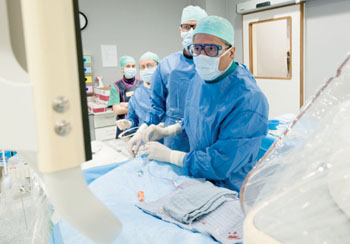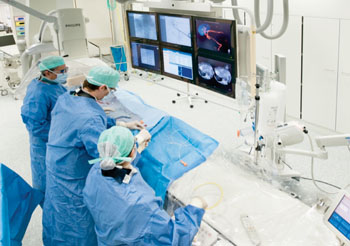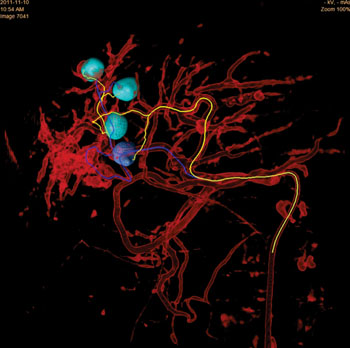3D Image Guidance Tool Designed to Visualize, Target, and Treat Tumor Lesions
|
By MedImaging International staff writers Posted on 26 May 2014 |

Image: Prof. Maleux, interventional radiologist at University Hospital Louvain (Belgium) and his team are performing an embolization procedure (Photo courtesy of Philips Healthcare).

Image: Embolization procedure with Philips EmboGuide at University Hospital Louvain (Belgium) (Photo courtesy of Philips Healthcare).

Image: EmboGuide 3D live image guidance tool to see, reach, and treat tumor lesions (Photo courtesy of Philips Healthcare).
A live three-dimensional (3D) image guidance application optimizes tumor embolization procedures on interventional X-ray systems.
Philips Healthcare (Best, The Netherlands) reported on the launch of EmboGuide, its latest technology in interventional oncology, to treat difficult-to-reach tumors or tumors in patients who are deemed unsuitable for surgery. EmboGuide is a live 3D image guidance tool that supports the increasing number of minimally invasive procedures. It is designed to be used with Philips’ interventional X-ray system to perform tumor embolization procedures. Such procedures involve blocking the arteries feeding a tumor to deprive it of nutrients and oxygen. They require the insertion of a catheter, which must be guided to the tumor site with the aid of live image-guidance.
Developed in collaboration with leading clinicians and partners such as BTG (Eclépens, Switzerland), a developer of interventional oncology systems, EmboGuide addresses the need for an enhanced 3D imaging system to make interventional oncology procedures more effective and easier to perform, and ultimately enhance patient outcomes. It provides interventional radiologists with the ability to visualize and characterize tumor lesions and plan and perform interventional procedures.
“Interventional oncology is a fast growing field that offers clinicians a viable treatment option for patients who are not suitable for surgical tumor removal,” said Gene Saragnese, CEO imaging systems at Philips Healthcare. “Together with our partners, we will leverage our combined expertise in image-guided interventions and therapies to accelerate this transformation from surgical procedures to minimally invasive treatments in oncology.”
A specific example of a tumor embolization procedure is transarterial chemo-embolization (TACE), used for palliative treatment of liver tumors. It involves simultaneous local administration of chemotherapy and beads that block the arteries feeding the liver tumor. “We can only treat what we see, yet the embolization of all blood vessels that feed the liver tumor lesion is key for an effective TACE procedure,” said Shiro Miyayama, MD, from the department of diagnostic radiology, Fukuiken Saisekai Hospital (Japan). “EmboGuide’s live 3D image guidance helps to improve the technical success of the procedure, as it can automatically identify the small tumor-feeders that are difficult to detect with conventional 2D angiographic imaging methods.”
The visualization feature of the EmboGuide utilizes the ultra-low X-ray dose settings of Philips’ AlluraClarity interventional X-ray system and the fast, high quality imaging of the abdomen of XperCT Dual. XperCT Dual’s enhanced imaging technique—multiphase cone beam CT—offers excellent 3D images of lesions, with detection accuracy that is superior to traditional 2D angiographic imaging. It offers clinicians better imaging of the treatment targets for optimized decision-making while performing the procedure. XperCT Dual has been found to be comparable to magnetic resonance imaging (MRI), which is considered to be the “gold standard.”
The reach feature of the EmboGuide helps to define the tumor lesions and features automatic identification of blood vessels that feed the lesions. It detects more than twice as many tumor feeding arteries compared to traditional imaging techniques, such as digital subtraction angiography (DSA). This allows interventional radiologists to optimize the catheter locations for embolization and plan a route to them. During the administration of the embolization agent, EmboGuide accurately superimposes the planning information onto the interventional X-ray system’s live images to monitor the treatment progress and determine its endpoint.
“In the treatment of intermediate HCC, the integrated use of our embolic device with image guidance is vital for successful treatment,” said Mike Motion, BTG general manager, interventional oncology. “As a leader in interventional oncology, we invest to improve the safety and efficacy of the procedure. Partnering with Philips has strengthened our ability to further develop this cohesive approach using DC Bead and Philips’ EmboGuide with the ultimate objective of advancing interventional oncology.”
The launch of EmboGuide is a result of Philips’ global investment in Healthcare R&D, which amounted to a total of EUR 780 million in 2013. It highlights Philips’ focus on interventional oncology—a rapidly developing market with a compound annual growth rate of approximately 15%.
Philips’ EmboGuide was presented at the Asia-Pacific Congress of Cardiovascular and Interventional Radiology (APCCVIR), held in Singapore from May 15-18, 2014. At the Congress, Dr. Miyayama shared his experiences with EmboGuide in a scientific presentation.
Related Links:
Philips Healthcare
BTG
Philips Healthcare (Best, The Netherlands) reported on the launch of EmboGuide, its latest technology in interventional oncology, to treat difficult-to-reach tumors or tumors in patients who are deemed unsuitable for surgery. EmboGuide is a live 3D image guidance tool that supports the increasing number of minimally invasive procedures. It is designed to be used with Philips’ interventional X-ray system to perform tumor embolization procedures. Such procedures involve blocking the arteries feeding a tumor to deprive it of nutrients and oxygen. They require the insertion of a catheter, which must be guided to the tumor site with the aid of live image-guidance.
Developed in collaboration with leading clinicians and partners such as BTG (Eclépens, Switzerland), a developer of interventional oncology systems, EmboGuide addresses the need for an enhanced 3D imaging system to make interventional oncology procedures more effective and easier to perform, and ultimately enhance patient outcomes. It provides interventional radiologists with the ability to visualize and characterize tumor lesions and plan and perform interventional procedures.
“Interventional oncology is a fast growing field that offers clinicians a viable treatment option for patients who are not suitable for surgical tumor removal,” said Gene Saragnese, CEO imaging systems at Philips Healthcare. “Together with our partners, we will leverage our combined expertise in image-guided interventions and therapies to accelerate this transformation from surgical procedures to minimally invasive treatments in oncology.”
A specific example of a tumor embolization procedure is transarterial chemo-embolization (TACE), used for palliative treatment of liver tumors. It involves simultaneous local administration of chemotherapy and beads that block the arteries feeding the liver tumor. “We can only treat what we see, yet the embolization of all blood vessels that feed the liver tumor lesion is key for an effective TACE procedure,” said Shiro Miyayama, MD, from the department of diagnostic radiology, Fukuiken Saisekai Hospital (Japan). “EmboGuide’s live 3D image guidance helps to improve the technical success of the procedure, as it can automatically identify the small tumor-feeders that are difficult to detect with conventional 2D angiographic imaging methods.”
The visualization feature of the EmboGuide utilizes the ultra-low X-ray dose settings of Philips’ AlluraClarity interventional X-ray system and the fast, high quality imaging of the abdomen of XperCT Dual. XperCT Dual’s enhanced imaging technique—multiphase cone beam CT—offers excellent 3D images of lesions, with detection accuracy that is superior to traditional 2D angiographic imaging. It offers clinicians better imaging of the treatment targets for optimized decision-making while performing the procedure. XperCT Dual has been found to be comparable to magnetic resonance imaging (MRI), which is considered to be the “gold standard.”
The reach feature of the EmboGuide helps to define the tumor lesions and features automatic identification of blood vessels that feed the lesions. It detects more than twice as many tumor feeding arteries compared to traditional imaging techniques, such as digital subtraction angiography (DSA). This allows interventional radiologists to optimize the catheter locations for embolization and plan a route to them. During the administration of the embolization agent, EmboGuide accurately superimposes the planning information onto the interventional X-ray system’s live images to monitor the treatment progress and determine its endpoint.
“In the treatment of intermediate HCC, the integrated use of our embolic device with image guidance is vital for successful treatment,” said Mike Motion, BTG general manager, interventional oncology. “As a leader in interventional oncology, we invest to improve the safety and efficacy of the procedure. Partnering with Philips has strengthened our ability to further develop this cohesive approach using DC Bead and Philips’ EmboGuide with the ultimate objective of advancing interventional oncology.”
The launch of EmboGuide is a result of Philips’ global investment in Healthcare R&D, which amounted to a total of EUR 780 million in 2013. It highlights Philips’ focus on interventional oncology—a rapidly developing market with a compound annual growth rate of approximately 15%.
Philips’ EmboGuide was presented at the Asia-Pacific Congress of Cardiovascular and Interventional Radiology (APCCVIR), held in Singapore from May 15-18, 2014. At the Congress, Dr. Miyayama shared his experiences with EmboGuide in a scientific presentation.
Related Links:
Philips Healthcare
BTG
Latest Radiography News
- World's Largest Class Single Crystal Diamond Radiation Detector Opens New Possibilities for Diagnostic Imaging
- AI-Powered Imaging Technique Shows Promise in Evaluating Patients for PCI
- Higher Chest X-Ray Usage Catches Lung Cancer Earlier and Improves Survival
- AI-Powered Mammograms Predict Cardiovascular Risk
- Generative AI Model Significantly Reduces Chest X-Ray Reading Time
- AI-Powered Mammography Screening Boosts Cancer Detection in Single-Reader Settings
- Photon Counting Detectors Promise Fast Color X-Ray Images
- AI Can Flag Mammograms for Supplemental MRI
- 3D CT Imaging from Single X-Ray Projection Reduces Radiation Exposure
- AI Method Accurately Predicts Breast Cancer Risk by Analyzing Multiple Mammograms
- Printable Organic X-Ray Sensors Could Transform Treatment for Cancer Patients
- Highly Sensitive, Foldable Detector to Make X-Rays Safer
- Novel Breast Cancer Screening Technology Could Offer Superior Alternative to Mammogram
- Artificial Intelligence Accurately Predicts Breast Cancer Years Before Diagnosis
- AI-Powered Chest X-Ray Detects Pulmonary Nodules Three Years Before Lung Cancer Symptoms
- AI Model Identifies Vertebral Compression Fractures in Chest Radiographs
Channels
MRI
view channel
AI Tool Tracks Effectiveness of Multiple Sclerosis Treatments Using Brain MRI Scans
Multiple sclerosis (MS) is a condition in which the immune system attacks the brain and spinal cord, leading to impairments in movement, sensation, and cognition. Magnetic Resonance Imaging (MRI) markers... Read more
Ultra-Powerful MRI Scans Enable Life-Changing Surgery in Treatment-Resistant Epileptic Patients
Approximately 360,000 individuals in the UK suffer from focal epilepsy, a condition in which seizures spread from one part of the brain. Around a third of these patients experience persistent seizures... Read more
AI-Powered MRI Technology Improves Parkinson’s Diagnoses
Current research shows that the accuracy of diagnosing Parkinson’s disease typically ranges from 55% to 78% within the first five years of assessment. This is partly due to the similarities shared by Parkinson’s... Read more
Biparametric MRI Combined with AI Enhances Detection of Clinically Significant Prostate Cancer
Artificial intelligence (AI) technologies are transforming the way medical images are analyzed, offering unprecedented capabilities in quantitatively extracting features that go beyond traditional visual... Read moreUltrasound
view channel
AI Identifies Heart Valve Disease from Common Imaging Test
Tricuspid regurgitation is a condition where the heart's tricuspid valve does not close completely during contraction, leading to backward blood flow, which can result in heart failure. A new artificial... Read more
Novel Imaging Method Enables Early Diagnosis and Treatment Monitoring of Type 2 Diabetes
Type 2 diabetes is recognized as an autoimmune inflammatory disease, where chronic inflammation leads to alterations in pancreatic islet microvasculature, a key factor in β-cell dysfunction.... Read moreNuclear Medicine
view channel
Novel PET Imaging Approach Offers Never-Before-Seen View of Neuroinflammation
COX-2, an enzyme that plays a key role in brain inflammation, can be significantly upregulated by inflammatory stimuli and neuroexcitation. Researchers suggest that COX-2 density in the brain could serve... Read more
Novel Radiotracer Identifies Biomarker for Triple-Negative Breast Cancer
Triple-negative breast cancer (TNBC), which represents 15-20% of all breast cancer cases, is one of the most aggressive subtypes, with a five-year survival rate of about 40%. Due to its significant heterogeneity... Read moreGeneral/Advanced Imaging
view channel
AI-Powered Imaging System Improves Lung Cancer Diagnosis
Given the need to detect lung cancer at earlier stages, there is an increasing need for a definitive diagnostic pathway for patients with suspicious pulmonary nodules. However, obtaining tissue samples... Read more
AI Model Significantly Enhances Low-Dose CT Capabilities
Lung cancer remains one of the most challenging diseases, making early diagnosis vital for effective treatment. Fortunately, advancements in artificial intelligence (AI) are revolutionizing lung cancer... Read moreImaging IT
view channel
New Google Cloud Medical Imaging Suite Makes Imaging Healthcare Data More Accessible
Medical imaging is a critical tool used to diagnose patients, and there are billions of medical images scanned globally each year. Imaging data accounts for about 90% of all healthcare data1 and, until... Read more
Global AI in Medical Diagnostics Market to Be Driven by Demand for Image Recognition in Radiology
The global artificial intelligence (AI) in medical diagnostics market is expanding with early disease detection being one of its key applications and image recognition becoming a compelling consumer proposition... Read moreIndustry News
view channel
GE HealthCare and NVIDIA Collaboration to Reimagine Diagnostic Imaging
GE HealthCare (Chicago, IL, USA) has entered into a collaboration with NVIDIA (Santa Clara, CA, USA), expanding the existing relationship between the two companies to focus on pioneering innovation in... Read more
Patient-Specific 3D-Printed Phantoms Transform CT Imaging
New research has highlighted how anatomically precise, patient-specific 3D-printed phantoms are proving to be scalable, cost-effective, and efficient tools in the development of new CT scan algorithms... Read more
Siemens and Sectra Collaborate on Enhancing Radiology Workflows
Siemens Healthineers (Forchheim, Germany) and Sectra (Linköping, Sweden) have entered into a collaboration aimed at enhancing radiologists' diagnostic capabilities and, in turn, improving patient care... Read more


















